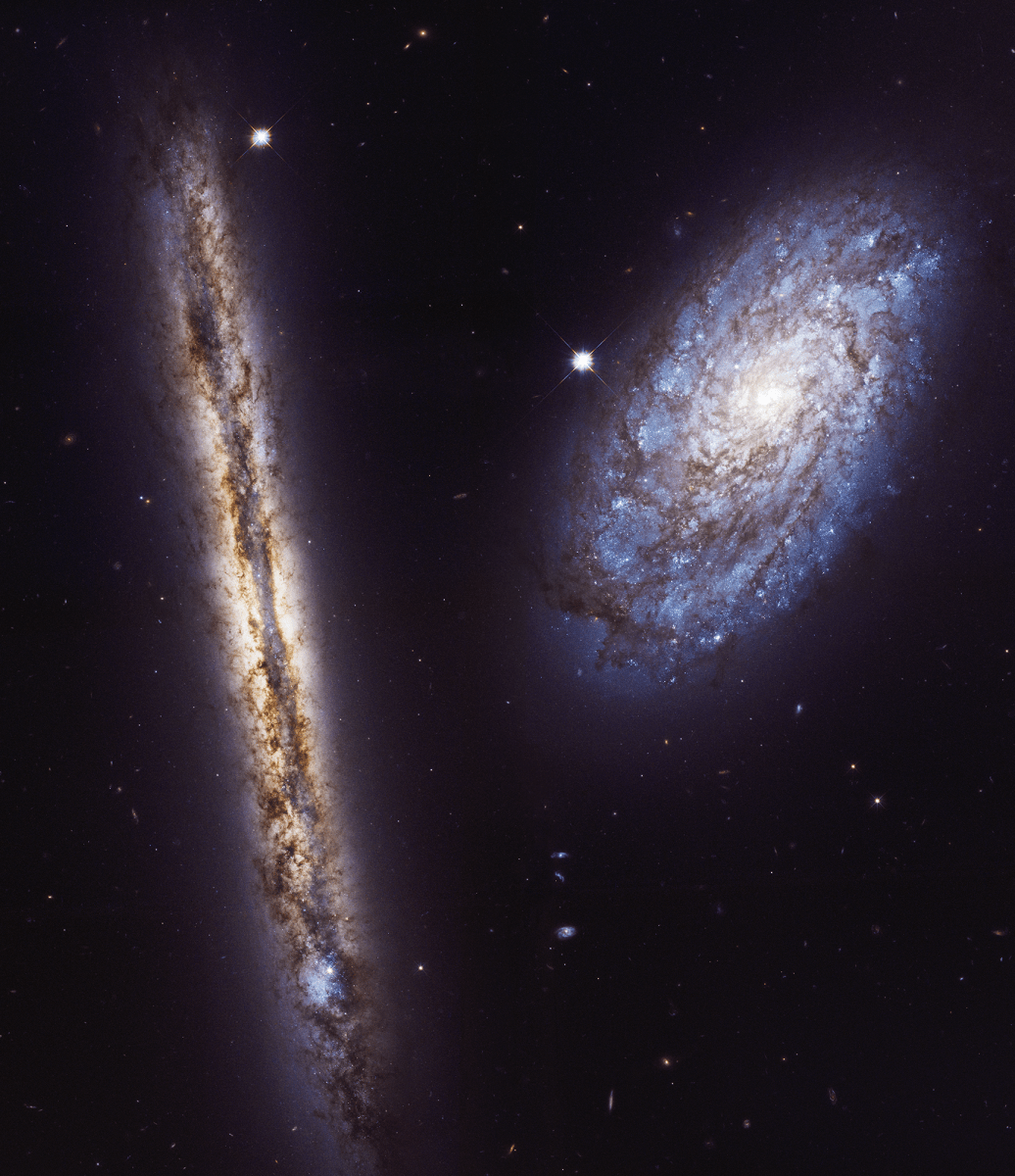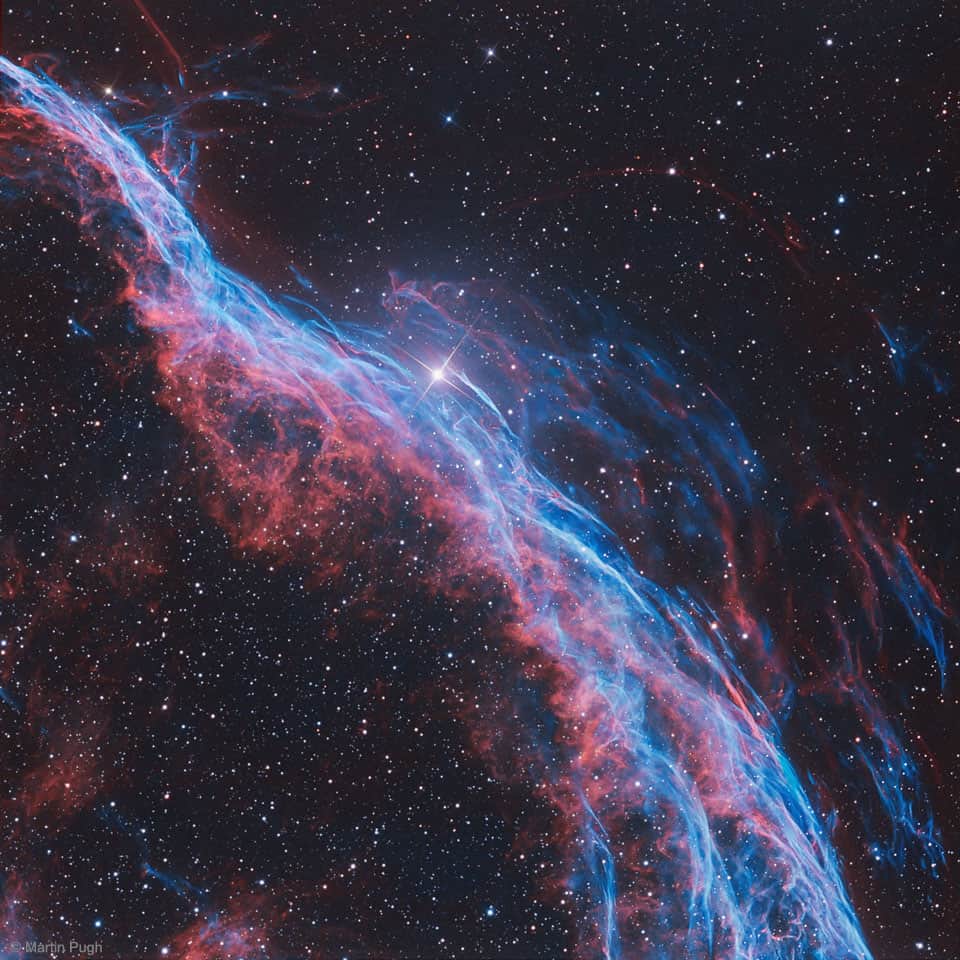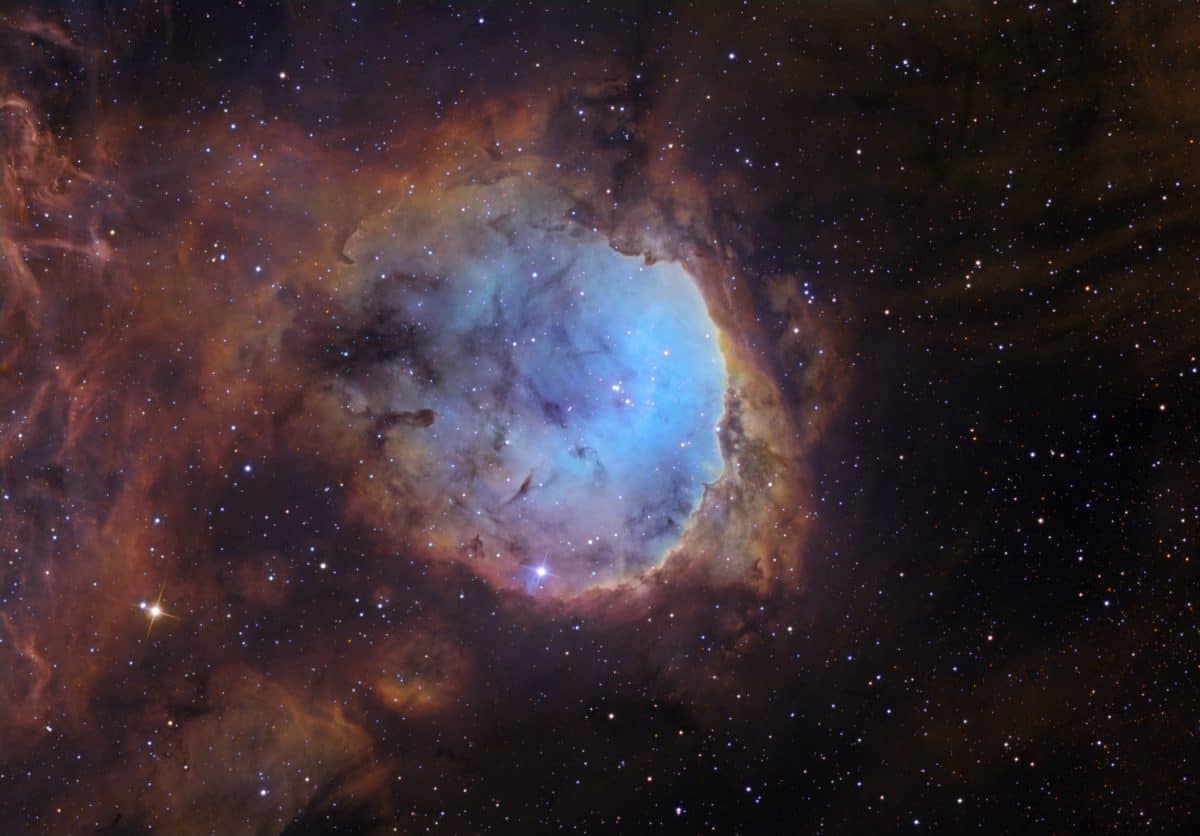Blog
In celebration of the 27th anniversary of the launch of NASA’s Hubble Space Telescope on April 24, 1990, astronomers used the legendary telescope to take a portrait of a stunning pair of spiral galaxies. This starry pair offers a glimpse of what our Milky Way galaxy would look like to an outside observer.
The edge-on galaxy is called NGC 4302, and the tilted galaxy is NGC 4298. These galaxies look quite different because we see them angled at different positions on the sky. They are actually very similar in terms of their structure and contents.
From our view on Earth, researchers report an inclination of 90 degrees for NGC 4302, which is exactly edge on. NGC 4298 is tilted 70 degrees.
In NGC 4298, the telltale, pinwheel-like structure is visible, but it’s not as prominent as in some other spiral galaxies. In the edge-on NGC 4302, dust in the disk is silhouetted against rich lanes of stars. Absorption by dust makes the galaxy appear darker and redder than its companion. A large blue patch appears to be a giant region of recent star formation.
Both galaxies are approximately 55 million light-years away. They reside in the constellation Coma Berenices in the Virgo Cluster of nearly 2,000 galaxies. Both were discovered in 1784 by astronomer William Herschel. Such objects were first simply called “spiral nebulas,” because it wasn’t known how far away they were. In the early 20th century, Edwin Hubble discovered that galaxies are other island cities of stars far outside our Milky Way.
A typical spiral galaxy has arms of young stars that wind outward from its center. The bright arms are regions of intense star formation. Such galaxies have a central bulge and are surrounded by a faint halo of stars. Many spiral galaxies also have bars that extend from the central bulge to the arms.
The edge-on NGC 4302 is about 87,000 light-years in diameter, which is about 60 percent the size of the Milky Way. It is about 110 billion solar masses, approximately one-tenth of the Milky Way’s mass.
The tilted NGC 4298 is about 45,000 light-years in diameter, about one third the size of the Milky Way. At 17 billion solar masses, it is less than 2 percent of the Milky Way galaxy’s 1 trillion solar masses.
more...Stephen Kendall Gadd (born April 9, 1945) is an American drummer, percussionist, and session musician. Gadd is one of the most well-known and highly regarded session and studio drummers in the industry, recognized by his induction into the Modern Drummer Hall of Fame in 1984. Gadd’s performance on Paul Simon‘s “50 Ways to Leave Your Lover” and Steely Dan‘s “Aja” are examples of his style. He has worked with popular musicians from many genres, including Simon & Garfunkel, Steely Dan, James Taylor, Eric Clapton, Kate Bush, Joe Cocker, Grover Washington Jr., Chick Corea, Lee Ritenour, and Al Di Meola.
Gadd is a native of Irondequoit, New York, a suburb of Rochester. When he was seven years old, his uncle, a drummer in the US Army, encouraged him to take drum lessons. By the age of eleven Gadd had sat in with Dizzy Gillespie. In a Modern Drummer interview Gadd mentioned that some of his influences at a young age and later on included Buddy Rich, Elvin Jones, Tony Williams, and the “less is more” style of Rick Marotta.
more...
Reuben Wilson (born April 9, 1935) is a jazz organist. He performs soul jazz and acid jazz, and is best known for his title track “Got to Get Your Own”.
He was born in Mounds, Oklahoma and his family moved to Pasadena when he was 5. He played in Los Angeles with drummer Al Bartee, then moved to New York to begin a recording career. In addition to playing with jazz musicians Melvin Sparks and Willis Jackson, Wilson led the local band Wildare Express. He remains an active musician, and still resides in New York City.
https://www.youtube.com/watch?v=Ho6pJ1nrBq0
more...Mance Lipscomb (April 9, 1895 – January 30, 1976) was an American blues singer, guitarist and songster. He was born Beau De Glen Lipscomb near Navasota, Texas. As a youth he took the name Mance (short for emancipation) from a friend of his oldest brother, Charlie.
Lipscomb was born April 9, 1895. His father was an ex-slave from Alabama; his mother was half Native American (Choctaw). Lipscomb spent most of his life working as a tenant farmer in Texas.
He was discovered and recorded by Mack McCormick and Chris Strachwitz in 1960, during revival of interest in the country blues. He recorded many albums of blues, ragtime, Tin Pan Alley and folk music (most of them released by Strachwitz’s Arhoolie Records), singing and accompanying himself on acoustic guitar. Lipscomb had a “dead-thumb” finger-picking guitar technique and an expressive voice. He honed his skills by playing in nearby Brenham, Texas, with a blind musician, Sam Rogers. His first release was the album Texas Songster (1960). Lipscomb performed songs in a wide range of genres, from old songs like “Sugar Babe” (the first he ever learned) to pop numbers like “Shine On, Harvest Moon” and “It’s a Long Way to Tipperary”
more...Spirit on Two Strings
more...Creation Dub
4-9-18
https://www.youtube.com/watch?v=KwlIjw5zTmw&list=PLEB3LPVcGcWZ0hsQ5_jgSMhawAnDzy1io&index=15
more...Ten thousand years ago, before the dawn of recorded human history, a new light would have suddenly have appeared in the night sky and faded after a few weeks. Today we know this light was from asupernova, or exploding star, and record the expanding debris cloud as the Veil Nebula, a supernova remnant. This sharp telescopic view is centered on a western segment of the Veil Nebula cataloged as NGC 6960 but less formally known as the Witch’s Broom Nebula. Blasted out in the cataclysmic explosion, the interstellar shock wave plows through space sweeping up and exciting interstellar material. Imaged with narrow band filters, the glowing filaments are like long ripples in a sheet seen almost edge on, remarkably well separated into atomic hydrogen (red) and oxygen (blue-green) gas. The complete supernova remnant lies about 1400 light-years away towards the constellation Cygnus. This Witch’s Broom actually spans about 35 light-years. The bright star in the frame is 52 Cygni, visible with the unaided eye from a dark location but unrelated to the ancient supernova remnant.
more...
Stephen James Howe (born 8 April 1947) is an English musician, songwriter and producer, best known as the guitarist in the rock band Yes across three stints since 1970. Born in Holloway, North London, Howe developed an interest in the guitar and began to learn the instrument himself at age 12. He embarked on a music career in 1964, first playing in several London-based blues, covers, and psychedelic rock bands for six years, including the Syndicats, Tomorrow, and Bodast.
Upon joining Yes in 1970, Howe helped to establish the band’s change in sound, a change that led to their commercial and critical success. Many of their best-known songs were co-written by Howe, who remained with the band until they briefly disbanded in 1981. Howe returned to the group in 1990 for two years and has remained a full time member since 1995.
Howe achieved further success in the 1980s and beyond as a member of the rock bands Asia, GTR, and Anderson Bruford Wakeman Howe. He also has a prolific solo career, releasing 20 solo albums that reached varied levels of success and collaborated with artists such as Frankie Goes to Hollywood, Martin Taylor, and Queen. He continues to perform with Yes, as a member of his jazz group, the Steve Howe Trio, and as a solo act. In April 2017, Howe was inducted into the Rock and Roll Hall of Fame as a member of Yes.
more...Tommy McClennan (January 4, 1905 – May 9, 1961) was an American Delta blues singer and guitarist.
McClennan was born in Durant, Mississippi, and grew up in the town. He played and sang blues in a rough, energetic style.
He made a series of recordings for Bluebird Records from 1939 through 1942. He regularly played with his friend Robert Petway. His voice is heard in the background on Petway’s recording of “Boogie Woogie Woman” (1942). McClennan’s singles in this period included “Bottle It Up and Go“, “New Highway No. 51”, “Shake ‘Em on Down“, and “Whiskey Head Woman”
https://www.youtube.com/watch?v=n-3C8BvpZLA
more...Carmen Mercedes McRae (April 8, 1922 – November 10, 1994) was an American jazz singer. She is considered one of the most influential jazz vocalists of the 20th century and is remembered for her behind-the-beat phrasing and ironic interpretation of lyrics. McRae was inspired by Billie Holiday, but she established her own voice. She recorded over sixty albums and performed worldwide.
McRae was born in Harlem. Her father, Osmond, was originally from Costa Rica, and her mother, Evadne McRae, an immigrant from Jamaica. She began studying piano when she was eight, and the music of jazz greats such as Louis Armstrong and Duke Ellington filled her home. When she was just 17 years old she met singer Billie Holiday. As a teenager McRae came to the attention of Teddy Wilson and his wife, the composer Irene Kitchings Wilson. One of McRae’s early songs, “Dream of Life”, was, through their influence, recorded in 1939 by Wilson’s long-time collaborator Billie Holiday. McRae considered Holiday to be her primary influence. She was a lifelong active Democrat
more...Matato’a is a Chilean music and dance group from Rapa Nui (Easter Island) in the Pacific. The name of the group means The Warriors. It performs a combination of rock music with Rapa Nui, Polynesian and Latino styles.
more...Know the Right
4-8-18
https://www.youtube.com/watch?v=mCne0ScYGLA&list=PLEB3LPVcGcWZ0hsQ5_jgSMhawAnDzy1io&index=16
more...This composite picture created from images from several space- and ground-based telescopes tells the story of the hunt for an elusive missing object hidden amid a complex tangle of gaseous filaments in the Small Magellanic Cloud, a dwarf galaxy approximately 200,000 light-years from us outside the Milky Way Galaxy. The reddish background image comes from the NASA/ESA Hubble Space Telescope and reveals the wisps of gas forming the supernova remnant 1E 0102.2-7219 in green. The red ring with a dark center is from the MUSE instrument on ESO’s Very Large Telescope and the blue and purple images are from NASA’s Chandra X-Ray Observatory. The blue spot at the center of the red ring is an isolated neutron star with a weak magnetic field, the first identified outside the Milky Way.
more...
Frederick Dewayne Hubbard (April 7, 1938 – December 29, 2008) was an American jazz trumpeter. He was known primarily for playing in the bebop, hard bop, and post-bop styles from the early 1960s onwards. His unmistakable and influential tone contributed to new perspectives for modern jazz and bebop.
Ramón “Mongo” Santamaría Rodríguez (April 7, 1917 – February 1, 2003) was a rumba quinto master and an Afro-Cuban Latin jazz percussionist. He is most famous for being the composer of the jazz standard “Afro Blue“, recorded by John Coltrane among others. In 1950 he moved to New York City where he played with Perez Prado, Tito Puente, Cal Tjader, Fania All Stars, etc. He was an integral figure in the fusion of Afro-Cuban rhythms with R&B and soul, paving the way for the boogaloo era of the late 1960s. His 1963 hit rendition of Herbie Hancock‘s “Watermelon Man” (recorded on December 17, 1962) was inducted into the Grammy Hall of Fame in 1998.
Mongo Santamaría was one of a handful of Cuban congueros (“conga players”) who came to the United States in the 1940s and 1950s. Other notable congueros who came to the U.S. during that time include Armando Peraza, Chano Pozo, Francisco Aguabella, Julito Collazo, Carlos Vidal Bolado and Modesto Durán. Many[who?] consider Santamaría to have been the greatest conga drummer of the twentieth century.
Santamaría learned rumba as a kid in the streets of Havana’s Jesús María barrio. He reminisced: “In the neighborhood where I came from we had all kinds of music, mostly from Africa. We did not leave it alone; we changed it our way. The music we made dealt with religion and conversation. The drum was our tool and we used it for everything”. Gerard points out: “Santamaría, like other drummers of his generation, learned music in the streets by observing different drummers. When he started playing professionally, he learned on the job. His approach was utilitarian, not theoretical”.Santamaría was mentored on bongos and rumba quinto by Clemente “Chicho” Piquero, who played in Beny Moré’s band. He recalled: “I would go with Chicho and play the tumbadora and also the [quinto]. I would play everything because I learned a lot from Chicho—because he could play everything”.
https://www.youtube.com/watch?v=egDLqG6dtMQ&list=PLamqGIGc1bfLZFgusjTc1JVHWodOxn7Qn&index=21
more...Eleanora Fagan (April 7, 1915 – July 17, 1959), better known as Billie Holiday, was an American jazz musician and singer-songwriter with a career spanning nearly thirty years. Nicknamed “Lady Day” by her friend and music partner Lester Young, Holiday had a seminal influence on jazz music and pop singing. Her vocal style, strongly inspired by jazz instrumentalists, pioneered a new way of manipulating phrasing and tempo. She was known for her vocal delivery and improvisational skills, which made up for her limited range and lack of formal music education.
After a turbulent childhood, Holiday began singing in nightclubs in Harlem, where she was heard by the producer John Hammond, who commended her voice. She signed a recording contract with Brunswick Records in 1935. Collaborations with Teddy Wilson yielded the hit “What a Little Moonlight Can Do“, which became a jazz standard. Throughout the 1930s and 1940s, Holiday had mainstream success on labels such as Columbia Recordsand Decca Records. By the late 1940s, however, she was beset with legal troubles and drug abuse. After a short prison sentence, she performed at a sold-out concert at Carnegie Hall, but her reputation deteriorated because of her drug and alcohol problems.
Though she was a successful concert performer throughout the 1950s with two further sold-out shows at Carnegie Hall, Holiday’s bad health, coupled with a string of abusive relationships and ongoing drug and alcohol abuse, caused her voice to wither. Her final recordings were met with mixed reaction to her damaged voice but were mild commercial successes. Her final album, Lady in Satin, was released in 1958. Holiday died of cirrhosis on July 17, 1959. A posthumous album, Last Recording, was released following her death.
https://www.youtube.com/watch?v=R7VNrRS3Sv0
more...The Song of the Butterfly
more...Channel One Studio
4-7-18
[arve url=”https://www.youtube.com/watch?v=qLkZgugz5is&list=PLEB3LPVcGcWZ0hsQ5_jgSMhawAnDzy1io&index=20″ /]
more...This bright cosmic cloud was sculpted by stellar winds and radiation from the hot young stars of open cluster NGC 3324. With dust clouds in silhouette against its glowing atomic gas, the pocket-shaped star-forming region actually spans about 35 light-years. It lies some 7,500 light-years away toward the nebula rich southern constellation Carina. A composite of narrowband image data, the telescopic view captures the characteristic emission from ionized sulfur, hydrogen, and oxygen atoms mapped to red, green, and blue hues in the popular Hubble Palette. For some, the celestial landscape of bright ridges of emission bordered by cool, obscuring dust along the right side create a recognizable face in profile. The region’s popular name is the Gabriela Mistral Nebula for the Nobel Prize winning Chilean poet.
more...
John Paul Pizzarelli Jr. (born April 6, 1960) is an American jazz guitarist and vocalist. He has recorded over twenty solo albums and has appeared on more than forty albums by other recording artists, including Paul McCartney, James Taylor, Rosemary Clooney; his father, jazz guitarist Bucky Pizzarelli; and his wife, singer Jessica Molaskey.
The son of swing guitarist Bucky Pizzarelli, John Pizzarelli was born in Paterson, New Jersey. He started on guitar when he was six and played trumpet through his college years. He attended Don Bosco Preparatory High School, an all-boys Catholic school. In his teens, he performed with Benny Goodman, Les Paul, Zoot Sims, Slam Stewart, and Clark Terry.
He attended the University of Tampa and William Patterson College, though he has said that his most important teacher was his father from 1980–1990. During the 1980s, he established himself as a jazz guitarist and a vocalist. He released his debut solo album, I’m Hip (Please Don’t Tell My Father), in 1983.
more...More Posts
- Cosmos NGC 346
- Shujaat Khan
- Pete Townshend
- Tom Scott
- Sonny Fortune
- Cecil McBee
- World Music Trio Mandili
- Daily Roots The Revolutionaries
- Happy Birthday Hendrix
- Cosmos NGC 1097
- Rick Wakeman
- Kai Winding
- Big Joe Turner
- World Music Moreno Viglione
- Daily Roots Kailash
- Shabbat for the Soul Mt Zion
- Cosmos Aurora Banks Peninsula
- Bill Bruford
- Taj Mahal
- Jackie McLean



